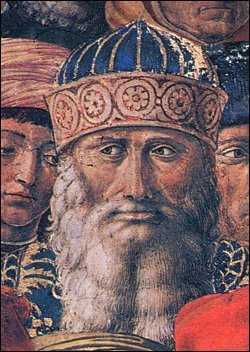Gemistus Pletho of Byzantium in the Procession of the Magi in the Palazzo Medici Riccardi in Florence by Benozzo Gozzoli (1459-60)
"I myself heard him at Florence ... asserting that in a few more years the whole world would accept one and the same religion with one mind, one intelligence, one teaching. And when I asked him “Christ’s or Muhammad’s?,” he said, “Neither; but it will not differ much from Paganism.” I was so shocked by these words that I hated him ever after and feared him like a poisonous viper, and I could no longer bear to see or hear him. I heard, too, from a number of Greeks who escaped here from the Peloponnese that he openly said before he died ... that not many years after his death Muhammad and Christ would collapse and the true truth would shine through every region of the globe."
— George of Trebizond, Comparatio Platonis et Aristotelis, fol. v63
"After his death, Plethon's Nómōn syngraphḗ (Νόμων συγγραφή) or Nómoi (Νόμοι, "Book of Laws") was discovered. It came into the possession of Princess Theodora, wife of Demetrios, despot of Morea. Theodora sent the manuscript to Scholarius, now Gennadius II, Patriarch of Constantinople, asking for his advice on what to do with it; he returned it, advising her to destroy it. Morea was under invasion from Sultan Mehmet II, and Theodora escaped with Demetrios to Constantinople where she gave the manuscript back to Gennadius, reluctant to destroy the only copy of such a distinguished scholar's work herself. Gennadius burnt it in 1460; however, in a letter to the Exarch Joseph (which still survives) he details the book, providing chapter headings and brief summaries of the contents. It seemed to represent a merging of Stoic philosophy and Zoroastrian mysticism, and discussed astrology, daemons and the migration of the soul. He recommended religious rites and hymns to petition the classical Gods, such as Zeus, whom he saw as universal principles and planetary powers. Man, as relative of the Gods, should strive towards good. Plethon believed the universe has no beginning or end in time, and being created perfect, nothing may be added to it. He rejected the concept of a brief reign of evil followed by perpetual happiness, and held that the human soul is reincarnated, directed by the Gods into successive bodies to fulfill divine order. This same divine order, he believed, governed the organisation of bees, the foresight of ants and the dexterity of spiders, as well as the growth of plants, magnetic attraction, and the amalgamation of mercury and gold.
Plethon drew up plans in his Nómoi to radically change the structure and philosophy of the Byzantine Empire in line with his interpretation of Platonism. The new state religion was to be founded on a hierarchical pantheon of Pagan Gods, based largely upon the ideas of humanism prevalent at the time, incorporating themes such as rationalism and logic. As an ad-hoc measure he also supported the reconciliation of the two churches in order to secure Western Europe's support against the Ottomans. He also proposed more practical, immediate measures, such as rebuilding the Hexamilion, the ancient defensive wall across the Isthmus of Corinth, which had been breached by the Ottomans in 1423.
The political and social elements of his theories covered the creation of communities, government (he promoted benevolent monarchy as the most stable form), land ownership (land should be shared, rather than individually owned), social organisation, families, and divisions of sex and class. He believed that labourers should keep a third of their produce, and that soldiers should be professional. He held that love should be private not because it is shameful, but because it is sacred."
-taken from wikipedia
 |
| Gemistus Pletho of Byzantium in the Procession of the Magi in the Palazzo Medici Riccardi in Florence by Benozzo Gozzoli (1459-60). |
 |
| "Procession of the Young King" segment. Pletho is in the middle of the group on center left. |
 |
| The full painting. Pletho on furthest left. |
 |
| Pletho (bottom left) standing beside his acquaintance and painter of the work, Benozzo Gozzoli (bottom center). |
 |
| The painting on the walls of the chapel. |
 |
| The painting on the walls of the chapel. |
Source:
https://commons.wikimedia.org/wiki/File:Benozzo_Gozzoli,_Pletone,_Cappella_dei_Magi.jpg
https://www.wga.hu/html_m/g/gozzoli/3magi/1/index.html
https://en.wikipedia.org/wiki/File:Gozzoli_magi.jpg
https://www.wga.hu/html_m/g/gozzoli/3magi/index.html
http://www.travelingintuscany.com/art/benozzogozzoli/processionofthemagi.htm
https://karavaki.wordpress.com/2019/05/12/hellenism-west_5/
Quote:



Comments
Post a Comment